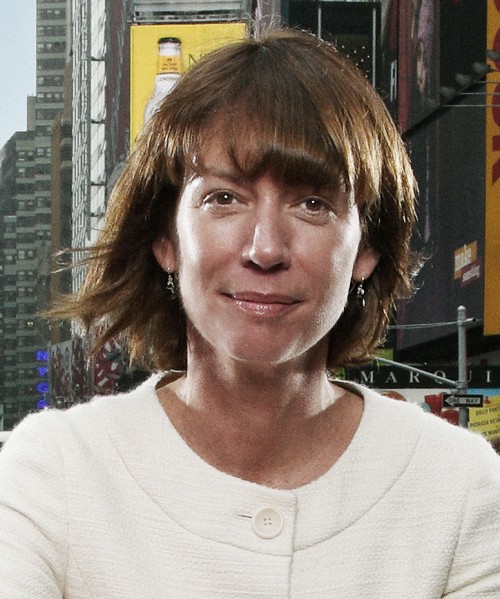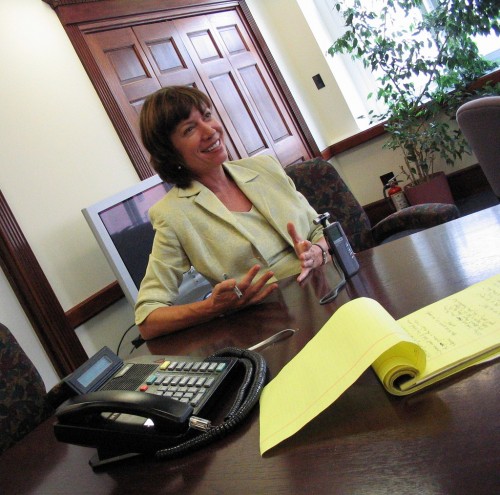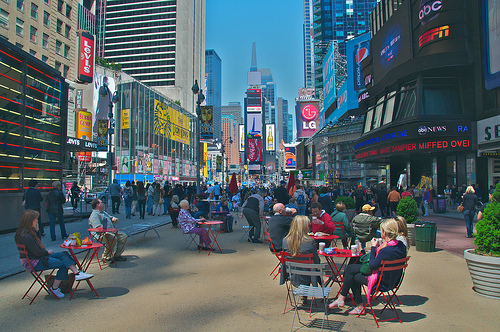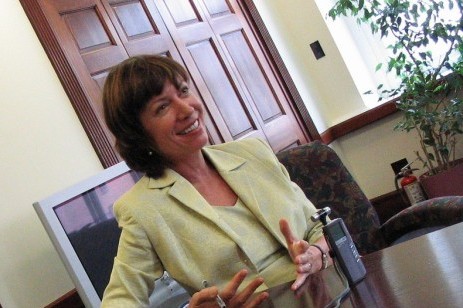 Janette Sadik-Khan.Photo: Olugbenro OgunsemoreExciting. Controversial. Radical. Glamorous.
Janette Sadik-Khan.Photo: Olugbenro OgunsemoreExciting. Controversial. Radical. Glamorous.
Not adjectives that generally leap to mind when you’re discussing a city’s department of transportation.
But since Janette Sadik-Khan was named commissioner of New York City’s DOT back in 2007, she’s been all those things, and so have her policies. Working within the framework of Mayor Michael Bloomberg’s PlaNYC 2030 initiative, which sets ambitious goals for the greening of America’s biggest city, Sadik-Khan has undertaken a number of kickass initiatives to reconfigure the streets of New York — giving primacy to people over automobiles for the first time since Robert Moses started running freeways through the city.
She’s created hundreds of miles of new bike lanes, inaugurated a hugely popular “Summer Streets” event, experimented with innovations in Bus Rapid Transit, and, most dramatically, pedestrianized two of New York’s legendary crossroads — Herald Square and Times Square.
All this has caused Sadik-Khan, who came to the job from the engineering firm Parsons Brinckerhoff, to inspire rock-star levels of adoration among fans in the biking and urban-planning community. She even dresses like a rock star: When I met her for an interview at the DOT’s downtown offices overlooking New York Harbor, she was wearing a black leather number cut well above the knee. She explained that she was going to a benefit that night for the nonprofit Recycle-A-Bicycle, and she had to “at least pretend to be cool.” No need to pretend.
But Sadik-Khan’s focus on bicycles and pedestrians — often at the expense of cars — has also caused a lot of blowback, especially from press outlets such as The New York Post (“Strangled by bikes: Transport commish is out of control,” screamed a recent headline). Brooklyn Borough President Marty Markowitz has regularly expressed his outrage over a protected bike lane running along Prospect Park, most recently in a somewhat bizarre Christmas card. Pedestrian refuges, designed to make it easier for seniors to cross busy streets, have been slammed as “concrete chaos” by a local TV station.
Sadik-Khan seems unperturbed by her critics and determined to press ahead, saying that analysis shows the redesigns have been successful, and that the process always takes community needs into account. When we met, she talked about allocating street space fairly, the connection between safety and sustainability, and the importance of boldness.
Q. When you came into the DOT job, you almost immediately started shaking things up, in a way that I think was unexpected to a lot of people. What were your priorities?
 Sadik-Khan, looking at transportation from a different angle.Photo: Brad AaronA. I was appointed at about the same time that PlaNYC was announced by Mayor Bloomberg. In the run-up to the appointment, I spent a lot of time with his senior team, talking about the priorities that I thought that we should be focusing on at the Department of Transportation. They were basically chapter and verse in PlaNYC. So it was a wonderful meeting of the minds. The importance of improving the quality of life, and the economic health of the city is a huge priority for me.
Sadik-Khan, looking at transportation from a different angle.Photo: Brad AaronA. I was appointed at about the same time that PlaNYC was announced by Mayor Bloomberg. In the run-up to the appointment, I spent a lot of time with his senior team, talking about the priorities that I thought that we should be focusing on at the Department of Transportation. They were basically chapter and verse in PlaNYC. So it was a wonderful meeting of the minds. The importance of improving the quality of life, and the economic health of the city is a huge priority for me.
The thing that I loved about PlaNYC is that it wasn’t just a conceptual plan, or a set of principles that got stuck on a bookshelf. It’s a really detailed action plan with benchmarks. For us, the Department of Transportation, it became a game plan for how we look at our streets, so that we are designing greener mobility into our street grid. We are looking at our streets differently, and treating them as the valuable public spaces that they are. With 6,000 miles of streets, that’s a lot of real estate to work with. We’re looking to create world-class streets that work better for everyone who uses them, and are more inviting.
Q. Under you, the department has focused on reallocating space — taking some of the space back from cars, for pedestrians and bicycles.
A. I look at it as balance. About a third of New Yorkers walk, about a third of New Yorkers take transit, and about a third of New Yorkers drive. We haven’t allocated our street space accordingly.
When you think about it, so many things have changed in the last 25 years in New York City. Crime is down, our schools are better, parks are better. The one thing that hasn’t changed in 25 years are our streets. No business would be in business for 25 years if they hadn’t changed the way they worked.
We’re looking to serve everyone, whether you walk, whether you bike, whether you drive, whether you take the subway or take the bus. And making our streets as safe as they can be for everyone. It’s the number one mission of the Department of Transportation: safe and efficient movement of people and goods. We’ve made some great progress. The traffic fatalities are the lowest that they’ve been in 100 years, since the city started keeping records in 1910. Traffic around Madison Square Park has been reconfigured to incorporate improved bike lanes and a public plaza: “We’re looking to create world-class streets that work better for everyone who uses them, and are more inviting.”Photo: NYC DOT
Traffic around Madison Square Park has been reconfigured to incorporate improved bike lanes and a public plaza: “We’re looking to create world-class streets that work better for everyone who uses them, and are more inviting.”Photo: NYC DOT
When you think about it, safety and sustainability are deeply intertwined. You can’t get people to ride a bike if they don’t feel safe. You can’t get more people onto a bus if they feel like the streets are dangerous. They go so deeply together. I can’t wish people onto bikes or buses or trains. I have to make the streets be as safe as they can be so people feel comfortable in them.
Q. Why do you think that, in a city where there is such a low percentage of car ownership relative to the rest of the country, that there continues to be so much political and press push-back against anything that might make drivers even slightly uncomfortable?
A. Every project that we undertake has detractors. I think that inaction would have its own set of detractors as well. I think that there is well-covered opposition, but I also think that there is uncovered vocal and deep support for these projects in communities. You see that every time you see demonstrations out there. [On] Prospect Park
West, a group of people [were] demonstrating against it, [but it] turned out people three to one out there were in support of the project.
Every single project that we do, bike project, bus project, or otherwise, goes through the community board. It’s been approved by the community board. We work very, very hard to tailor these projects to meet the needs of local businesses and residents. No project is perfect right out of the box, so we go back and tweak them, and do everything we can to adjust them so they work better. I think we’ve been pretty successful at that.
Change is hard. Change is difficult. I like to say that people support change as long as things look exactly as they did before.
Q. You talked earlier about the economic aspect of things also being an important part of the work you do.
 The new, pedestrianized Times Square: “The alchemy of sustainable streets is part art and part science.”Photo: Ed YourdonA. Take for example Times Square and Herald Square, which are probably our most iconic projects. We’re doing a lot of work all around the city, but those have garnered the most attention. It was an idea that people found counterintuitive, that we would take Broadway out of the system and pedestrianize it, and make traffic work better, make it safer, and make it [good for] business. And in fact, that’s what happened.
The new, pedestrianized Times Square: “The alchemy of sustainable streets is part art and part science.”Photo: Ed YourdonA. Take for example Times Square and Herald Square, which are probably our most iconic projects. We’re doing a lot of work all around the city, but those have garnered the most attention. It was an idea that people found counterintuitive, that we would take Broadway out of the system and pedestrianize it, and make traffic work better, make it safer, and make it [good for] business. And in fact, that’s what happened.
By closing Broadway between 42nd and 47th Street, we improved the travel time on 7th Avenue. [There’s been a] 63 percent reduction in pedestrian injuries.
On the business side, retail rents in the pedestrian area in Times Square went up 71 percent in the last six months, which is the largest increase in the city’s history. You’re seeing five new flagship stores that just said they were going to relocate there. You’ve got hotels that are upping their game and improving the face of their buildings in the area. It’s generated a tremendous response.
Mayor Bloomberg has made it a big priority of his to ensure that we are collecting data before and after each of these projects are done. He’s a data-driven mayor that supports innovative change as long as you can document your findings. When you think about it, his decision to permanently close Times Square came in the middle of a reelection campaign. That is remarkable. The political courage that the mayor has shown, and the data analysis that he demands, is unique in this era. It’s been a pleasure to work with him, and I think that we’re going to see more innovation thanks to his leadership in these areas.
Q. You are looked to by many people around the country as an example for the work you’ve done here. But obviously New York is an exceptional case in a lot of ways — I think it’s easy for some people to say, oh, that’ll work in New York, but it’s not going to work anywhere else.
A. Actually, I don’t think that’s true. I think if we can make it work here, you can make it work almost anywhere. My advice is to be bold. The alchemy of sustainable streets is part art and part science. Be bold, have a vision, lay out where you want to go. That creates buy-in for the initiatives that you pursue.
The second thing is you don’t have to have a big budget to have a big impact. We’ve done a lot of transportation on our streets with low cost treatments. Painting curbs, painting green plazas, planters, repurposed blocks from bridge reconstruction projects. You can do a lot to transform a street without a big capital budget. People are also tired of waiting years and years to see changes.
I think that’s why the New York example has resonated around the country and around the world. In the last three years, we’ve transformed some really important parts of the city, not spending very much money at all.



